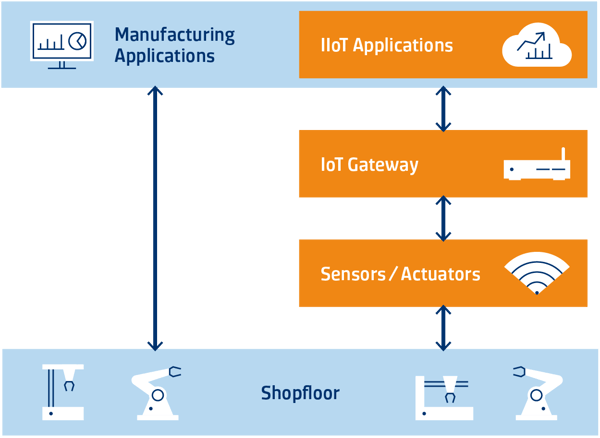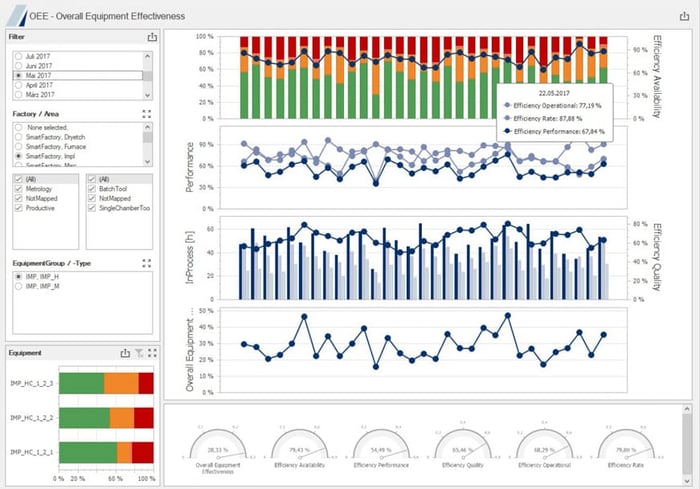Significant advances have been made in the areas of manufacturing IT and automation solutions over the past 5 years. However, production managers still don’t always have information about all of the machines on the shop floor to fully optimize the operational performance of their manufacturing sites. The missing pieces usually involve the current and historical states of equipment and machines which leads to inability to:
- accurately assess the current state and utilization of equipment
- identify which machines are bottleneck
- determine which machines are not running at their full potential
- recognize which equipment has problems and down time in general
- easily spot equipment that is wasting energy and resources
- pinpoint which machines are experiencing idle time as a result of missing workers/operators
- identify and locate carriers and material
Efficient maintenance planning and scheduling is also hindered by not exactly knowing the machine usage, conditions, and trends which are indicative that maintenance is required. Furthermore, to fully leverage applications such as predictive maintenance and AI-driven dispatching/scheduling, it is necessary to know the current and historical states of all equipment and machinery on the shop floor.
What is the Industrial Internet of Things (IIoT)?
Industrial Internet of Things (IIoT) is the key to gather additional data from your shopfloor and gain crucial insights for optimization. This typically involves adding sensors to your machines to measure physical parameters, such as vibration, temperature or power consumption, or to capture more advanced data with barcode readers or cameras. Additionally, actuators like displays or relays can feed back information to the machine. All of these devices have in common that (maybe with the help of a small industrial PC) they transmit data via standard internet communication protocols (TCP/IP), which makes it easy to connect them to data processing applications running in your factory network or the internet. These IIoT applications process the measurements and transform them into valuable information, such as “the machine is running” or “new material has arrived”. This information can be used by higher level systems, for example, to optimize the machine workload or to verify if a work piece is supposed to be processed at that machine. An IIoT application could then trigger the display of a warning at the machine. In doing so, users can identify incorrectly placed batches of material whose barcode has just been scanned in order to prevent misprocessing and scrap events. Comprehensive IIoT solutions comprised of smart devices, TCP/IP-based connectivity and a smart application add a lot of value to an existing manufacturing automation system.
The following discussion provides information on specific aspects of a comprehensive IIoT solution, including:
- IIoT connectivity to enable data collection, information creation, and remote control
- Integration of IIoT solutions to enable manufacturing process optimizations
- Availability, reliability, and compatibility with existing manufacturing IT
- Getting started step-by-step
IIoT Connectivity & Data
Ideally, equipment vendors offer an option to integrate and even remotely control shopfloor equipment via a communication interface. For example, SECS is standard in the semiconductor industry, manufacturing equipment often has an MTConnect interface, and OPC UA and Web Services are more generic examples. However, such options may not be available sometimes or come with prohibitive costs. If the equipment doesn’t provide an adequate communication interface and, therefore, is not integrated within the manufacturing IT landscape, current and historical equipment data is lacking.
The Industrial Internet of Things (IIoT) offers powerful and cost-effective options to upgrade such equipment. With IIoT, it becomes possible to build the equipment’s digital twin – a virtual model representing the physical and functional features of the real machine.
IIoT solutions bridge the gap between manufacturing equipment and IT applications, providing connectivity that would otherwise not be possible. IIoT enables the transmission and processing of a machine’s status (is it up? is it down? is it processing material? etc.) to all relevant manufacturing IT applications. By instrumenting the equipment in question with sensors and/or actuators, its state can be measured and adjusted. These sensors and actuators are connected to a minimalistic industrial computer (IoT Gateway) deployed next to the equipment. The IoT Gateway routes the equipment data to/from other manufacturing IT applications as needed.
Imagine, for example, a standalone machine with internal automation but no communication interface to the outside world. If the operator pushes the start button, the machine would start to process all units that are available at the input port. However, there is no way of automatically tracking the machine status to enable a higher level of automation or optimization. An IIoT solution can close that gap. For example, the green “running” signal light of the machine could be connected to an IoT Gateway’s digital input to measure and report the machine’s productive time. An additional presence sensor at the material input could trigger a warning if material is missing, or enable counting the number of produced units. The gathered data would then be processed by the IoT gateway, ingested into the digital twin model within the IIoT application and made available via an interface meeting the factory IT requirements (e.g. web services, MQTT, Apache Kafka, Azure IoT Hub, TIBCO/RV, or others). Via this interface, an OEE application can easily consume the data to generate statistics and throughput KPIs.
Other use cases include:
- Complementing an existing equipment interface with IIoT: If, for example, an interface doesn’t provide information about the machine’s power consumption. IIoT power sensors may be installed to provide more transparency of the machine's current status. With this additional data, the digital twin of the machine could be enriched to better understand the current equipment status and to enable further optimization.
- Facilitating the transition to “Place-and-Go” processing: Adding sensors and components (for example RFID readers for automatic material identification) to equipment that is already integrated facilitates the transition from manual material identification by the worker to a highly automated place-and-go scenario. Place-and-go capabilities then lay the foundation to enable automated material handling to be done by transport systems, autonomous vehicles and robots.
Leveraging IIoT provides valuable functionality and insights today, while enabling future opportunities to take advantage of advanced automation concepts which will take manufacturing to the next level.
IIoT Benefits
In order to reap the full rewards of IIoT solutions, they must be integrated with applications relevant for production, such as an Overall Equipment Effectiveness (OEE), the manufacturing execution system (MES), and/or a plant maintenance (PM) module in the enterprise resource planning (ERP) system. This integration connects the information from all involved components in order to:
Benefits
Replace error-prone manual processes with automation, such as automatic data collection in the MES
Identify machine idle time and determine the cause (e.g. machine is idle because, according to the MES, there is no job for it or no worker is present)
Inhibit processing at a machine if other manufacturing applications do not allow this operation
Complement manufacturing data with additional context information, for example, identification of the current machine program or recipe
Predictive maintenance
Enable “place-and-go” capabilities

Although, IIoT concepts and technology have matured considerably over last years, it remains a challenging task to implement such solutions. In particular, the velocity, the volume, and variety of these data require scalable infrastructure and a cutting-edge computing paradigm. The key to success is an efficient approach to model stream event processing to ensure fault-tolerant, exactly-once semantics at millisecond precision.
IIoT Solutions
IoT solutions must provide the same availability and reliability level as the other factory assets and systems while also fulfilling functional, system, and cost requirements. As such, these solutions must embed into the existing factory automation and management. Apart from that, the solution also has to take availability and reliability requirements and potential performance restrictions of the existing IT infrastructure into account. Only if these requirements are met, IoT applications become real Industry 4.0 solutions complementing the backbone of automated manufacturing sites. Simply stated, IIoT solutions are not “plug-and-play”, but have to be carefully architected and developed to ensure high ROI and stability.
Leveraging IIoT to the fullest extent is achievable but requires a high level of expertise, thoughtful implementation, and oversight. At a minimum, an IIoT deployment and management system is necessary in order to:
- enable reliable software/firmware updates to IIoT devices with minimal effort required
- provide visibility into IoT gateway connectivity status to verify everything is connected and running properly
- ensure that a fleet of IIoT devices can be operated and managed smoothly
Getting Started
With the variety and maturity of components and systems available to build IIoT solutions, it’s now the right time to start building and augmenting digital interfaces to manufacturing equipment. Whether you’re looking to improve OEE, monitor and maximize energy and resource consumption, or quickly identify and locate carriers and material, IIoT solutions bridge the information gaps between manufacturing equipment and IT applications. Bridging these gaps enables capabilities ranging from achieving visibility into equipment usage and maintenance requirements all the way to the ability to leverage powerful AI-driven dispatching and scheduling applications. With IIoT connectivity enabling robust data collection, contextual information creation, and remote control capabilities for equipment, the foundation is set for iterative projects which will pave the way to increasing automation capabilities.
SYSTEMA has been providing software solutions and consulting on manufacturing automation for 30 years across many industries. We understand the risks and complexities associated with the implementation of new technologies within a live production environment. As such, we offer the support and services necessary to guide the change process from start to finish while empowering users to effectively leverage the system.
